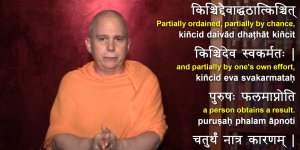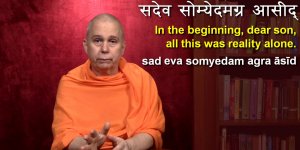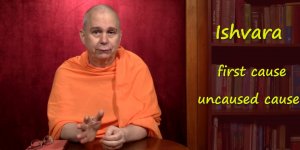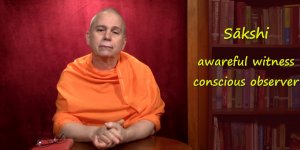| Titi Tudorancea TV / Documentaries |
Doctrine of Karma
Part 3/3: Sanchita, Prarabdha and Kriyamana Karma
A video presentation by Swami Tadatmananda Saraswati, Arsha Bodha Center, United States
(Tapescript) Welcome. In our two previous presentations on the doctrine of karma, we discussed the nature of adrishta phala, which describes the result of past actions that can fructify long after the karma was performed.
In this presentation, we’ll expand our perspective to examine the doctrine of karma as it pertains, not only to the present life, but to our past and future lives as well.
We can begin by noting a basic principle of the doctrine of karma, that is, you were born because of your past karma.
To understand this clearly, consider the circumstances immediately preceding your birth. At that time, many of the karmas you performed in past lives had not yet yielded all their results. A great deal of adrishta phala was waiting to fructify.
And, since YOU committed those actions, YOU must eventually reap the results.
But unless you’re alive, it’s impossible for all that phala to fructify. Therefore, to enable your past actions to yield their results, the laws of karma act to bring about your birth.
Now you might ask, how much adrishta phala do you have that’s still waiting to fructify?
Well, that depends on how many lives you’ve had before.
In the Bhagavad Gita, Sri Krishna tells Arjuna in chapter 4, bahuni me vyatinani janmani tava carjuna, O Arjuna, me, for me, tava ca, and for you, there have been bahuni, many vyatitani, past janmani, lives.
Exactly how many lives?
According to the ancient rishis, we live in a cyclic universe. This universe was preceded by another, which was preceded by yet another, and so on.
Like a circle has no beginning or end, this cycle of creation and dissolution also has no beginning or end.
So, there was no first cycle of creation. Instead, an infinite number of universes have come and gone before.
And, in an infinite number of prior universes, how many times were you born?
According to the doctrine of karma, you’ve had an infinite number of prior births. Just as the universe had no first cycle of creation, so too, you had no first birth.
Why?
Birth is due to past karma, but, for your very first birth, how could there be any past karma? It’s impossible.
Therefore, you must have had an infinite number of prior lives. And, in an infinite number of prior lives, you’ve certainly committed an infinite number of karmas.
Each and every one of those karmas produced adrishta phala.
As a result, over all your past lives, you’ve accumulated an infinite amount of adrishta phala which is now waiting to fructify.
The good news is that you’ve accumulated an infinite amount of punya which will bring happiness to you in this and future lives.
The bad news is that you’ve also accumulated an infinite amount of papa which will bring suffering to you in this and future lives.
Now, we seem to have a problem.
If you’ve accumulated an infinite amount of punya and papa in your past lives, how long would it take for all that karma to fructify?
You’d need an infinitely long life to reap all those results. But, this life is finite. And in a finite life, only a finite amount of adrishta phala can possibly fructify. That means, only a PORTION of your infinite accumulation of punya and papa will be able to fructify in this life.
To explain all this, the doctrine of karma distinguishes three different kinds of karmas waiting to fructify.
The first is sanchita karma, which is the infinite accumulation of punya and papa we’ve been talking about. Sanchita literally means collected or accumulated.
The second kind is prarabdha karma, which is the finite portion of your sanchita karma that will fructify in this lifetime. Prarabdha literally means that which has begun. It describes the adrishta phala that is responsible for the beginning of this life.
There’s also a third kind of karma which we’ll discuss a bit later.
As we saw before, the laws of karma brought about your birth so that your past karmas could fructify. Specifically, it’s your prarabdha karma that will fructify in this life.
The punya and papa that makes up your prarabdha karma will gradually yield their fruits throughout this life. The fructification of punya will bring unexpected good things to your life, while the fructification of papa will bring unexpected problems to your life.
And, when all of your prarabdha karmas have finally fructified, your life will come to an end.
In this way, prarabdha karma determines the span of life.
Let me try to illustrate this. Suppose the sweet, juicy red apple represents punya, which is adrishta phala from a good deed you performed in a past life. The green apple, which is extremely sour and unpleasant, represents papa, which is adrishta phala from an adharmic deed you performed before.
In an infinite number of prior lives, you’ve accumulated an infinite amount of adrishta phala, and this is your sanchita karma.
From your sanchita karma, a finite amount of prarabdha karma comes forth and produces your birth.
That prarabdha karma will gradually fructify, bringing unexpected happiness and suffering to your life. And when that prarabdha is exhausted, your life comes to an end.
Then, a new batch of prarabdha will come forth and bring about another life. Then, when that gets exhausted, yet another birth will take place, and so on.
Some people are born with enough prarabdha karma to require 90 years or more for it to fructify.
Others are born with less prarabdha karma, resulting in correspondingly shorter lifetimes. Infant mortality can be explained in this way.
Now, let’s consider the particular punya and papa that makes up your prarabdha karma. More punya will bring more happiness to your life, while more papa will bring more suffering.
You could think of the punya and papa as forming a ratio. If the ratio is more or less equal, your prarabdha karma will produce a similar measure of happiness and suffering in your life.
But, suppose you were born with punya alone, and no papa whatsoever. The fructification of that prarabdha would create an extraordinarily wonderful life, entirely free from suffering.
But, it’s impossible to enjoy such a life as a human being on this planet. After all, even billionaires and movie stars get headaches.
Prarabdha karma that consists of punya alone is said to bring about a birth in svarga, heaven.
Svarga is not necessarily a particular place. More accurately, it describes a lifetime of sheer enjoyment, untainted by suffering, a lifetime that’s the product of pure punya.
On the other hand, suppose your prarabdha karma consisted only of papa, and no punya whatsoever. The fructification of that prarabdha would result in a life of intense, uninterrupted suffering.
Once again, that kind of life isn’t possible as a human being on this planet. Even in miserable slums and horrible war zones, laughter can still be heard from time to time.
Therefore, prarabdha karma that consists of papa alone is said to bring about a birth in naraka, hell.
Like svarga, naraka too is not necessarily a particular place. Rather, it describes a lifetime of suffering, unmitigated by any kind of enjoyment.
Such a lifetime is the product of pure papa.
We previously discussed how your life comes to an end when all your prarabdha karma has fructified. That means, if you get born in either svarga or naraka, your existence there is limited to one, finite lifetime.
That makes sense because svarga and naraka are not the result of your infinite sanchita karma; they’re the result of your finite prarabdha karma.
Sri Krishna himself teaches this in the 9th chapter of the Bhagavad Gita, where he says in verse 21, te tam bhuktva svarga-lokam vishalam kshine punye martya-lokam vishanti, te bhuktva, after they have enjoyed, tam vishalam svarga-lokam, that vast heavenly domain, kshine punye, when their punya has completely fructified, maryta-lokam vishanti, they return to the human domain.
In the same way, those born in naraka-loka, hell, will also return when all their papa has fructified.
Western religions generally profess that we have a single life which is followed by eternal heaven or hell.
However, from our perspective, this concept doesn’t stand up very well to logical scrutiny. An eternity in heaven would require an infinite number of good deeds, and an eternity in hell would require an infinite number of bad deeds.
When I was a young child, growing up in a Christian family, I was taught that if I committed a sin, and then died shortly thereafter, I would suffer in hell for all eternity.
Huh. What can a 7 year old boy possibly do that’s so dreadful as to deserve an eternity of punishment?
The doctrine of karma, on the other hand, teaches that svarga is the finite result of your finite punya karmas, and naraka is the finite result of your finite papa karmas.
Going to heaven, then, is like going on a holiday. You leave your home with a fixed amount of money to pay for your vacation, in Hawaii or wherever, and when all your money is spent, you have to return home. In the same way, when all your punya is exhausted, your enjoyment of heaven necessarily comes to an end.
Then again, going to hell is like going to prison. For your crime, you receive a sentence of an appropriate length, and after suffering in jail for that allotted time, you’re finally released from confinement. In the same way, when your papa is exhausted, your suffering in naraka inevitably comes to an end.
Life as a human being on this planet is considered to be the result of a mixture of punya and papa. For most people, that mixture is presumed to be about 50-50, resulting in an equal measure of happiness and suffering in this life.
But, that ratio is subject to being changed, leading to either more happiness or more suffering in life.
And this brings us to the third kind of karma.
In addition to sanchita karma and prarabdha karma, there’s a third kind, called kriyamana karma. It can also be referred to as agami karma.
Kriyamana means, that which is being done now, at the present time. It refers to the so-called good and bad deeds you perform in THIS life. These deeds are better known as punya karma and papa karma.
When you commit papa karmas, some of the adrishta phala produced will add to your sanchita karma and cause suffering in future lives. But, some of that adrishta phala will add to your prarabdha karma instead and cause suffering later in this life itself, as the illustration shows.
When that prarabdha karma fructifies in this life it changes the ratio of punya and papa, bringing more suffering to this life. That means, no matter how bad your life is now, you can make it even worse by committing more papa karmas.
Fortunately, you can also make your life better by performing more punya karmas. Some of the adrishta phala they produce will add to your sanchita karma and eventually bring happiness to future lives. But some of that adrishta phala will add to your prarabdha instead and fructify in this life itself, resulting in more happiness to this life.
This is all somewhat complicated, so I’d like to share with you a diagram that clearly and concisely summarizes everything we’ve discussed so far.
Your sanchita karma is an infinite accumulation of punya and papa.
From that sanchita karma, the portion known as prarabdha karma is responsible for bringing about a given birth.
If that prarabdha karma is punya alone, a lifetime in heaven will result, and if that prarabdha karma is papa alone, a lifetime in hell will result. Similar amounts of punya and papa give rise to a human birth.
Actions you do in this life result in kriyamana karma. Some of this will add to your sanchita karma and fructify in future lives, and some will add to your prarabdha karma and fructify in this life itself. This changes the balance of punya and papa, resulting in more happiness or more suffering in your present life.
After all your prarabdha karmas have fructified, this life comes to an end. Then, a new batch of prarabdha karmas give rise to your next birth. And when those prarabdha karmas are exhausted, you are born again, and so on.
Now, there’s one final question to consider.
Do the actions you perform in this life directly affect what happens in your next life?
This turns out to be a difficult question.
When you die, any adristha phala that has not yet fructified will merge with your infinite sanchita karma. As a result of this, the actions performed in this life will affect your next life only indirectly, by way of your sanchita karma.
But, because the karmas you will have done in this life are so minute in comparison to your infinite sanchita, few, if any, of those karmas are likely to be included in the next batch of prarabdha, which will fructify in your next life.
However, there are exceptions to this general principle.
In chapter 6 of the Bhagavad Gita, Sri Krishna says in verse 43, tatra tam buddhi-samyogam labhate paurva-dehikam yatate ca tato bhuyah samsiddhau kurunandana.
tatra, there, in the next life labhate, he gains buddhi-samyogam, the wisdom he was endowed with paurva-dehikam, in his prior life.
tatah ca, and thereafter, yatate bhuyah, he will again strive, samsiddhau, for perfection, kurunandana, O Arjuna.
Here, Sri Krishna describes what happens to those who exert tremendous effort to gain moksha, liberation, but unfortunately, fail to live long enough to reach that lofty goal. According to Sri Krishna, such people will pick up the thread, so to speak, in the very next life, continuing their spiritual journey where they left off.
But, the doctrine of karma, as explained so far, can’t account for this sequence of events.
There must be an additional factor involved here.
And that additional factor is called purva-janma samskara, a samskara, a deep impression formed in the purva-janma, prior life. The performance of extremely intense actions is said to leave a deep impression, a samskara, on the sukshma sharira, the subtle body.
At death, the sukshma sharira, subtle body, together with this samskara, leaves one physical body and acquires a new one.
Even though the nature of the new body is determined by prarabdha karma, the sukshma sharira that dwells within it can possess a samskara, a predisposition from the immediately preceding life.
Some people believe this explains the phenomenon of child prodigies, like Mozart who traveled throughout Europe giving stunning piano concerts at the age of 7. This also explains how a powerful inclination towards spiritual growth can persist from one life to the next.
Now, before we conclude, it’s really important to say that the doctrine of karma is not so precise and mathematical as this presentation might make it seem.
Even though our discussion has been firmly based both on scripture and on teachings from the oral tradition, it is not at all possible to predict or calculate what will happen at any point in time due to the fructification of adrishta phala.
As we saw before, adrishta phala can’t be observed or scientifically studied, so the SPECIFIC nature of adrishta phala is ultimately unknowable.
Fortunately, the GENERAL nature of adrishta phala can be understood.
And this general understanding can help us explain why bad things happen to good people; it can help us cope better when tragedy raises its fearful head, and it can help us more gracefully accept situations in life that are beyond our control.

Subscribe now to get unrestricted access to all resources, in all languages, throughout this web site!
Subscription Form
YOU MAY ALSO LIKE







Subscribe now to get unrestricted access to all resources, in all languages, throughout this web site!
Subscription Form